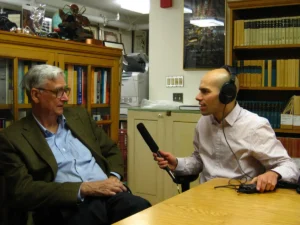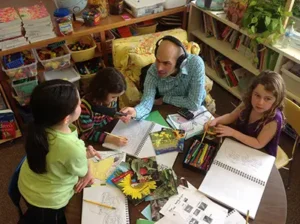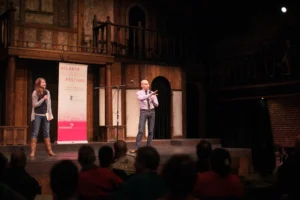
Ari Daniel is an independent radio and multimedia producer and the Boston producer of Story Collider. He has worked as a science reporter for The World and NOVA and has contributed numerous segments to public radio programming including NPR’s Morning Edition and All Things Considered, Radiolab, Studio 360, and Living on Earth. He completed his PhD in Biological Oceanography at the Woods Hole Oceanographic Institution and holds an M.Phil. in Animal Behaviour from the University of St. Andrews in Scotland.
He tends to focus on the personal stories of people in the scientific community and enjoys the challenge of trying to convey ideas through audio.
SCI: You started out as a scientist but switched to being a radio segment producer after getting your PhD How did that come about? What made you want to go into radio?
AD: Ever since I was a kid, I’ve been enamored of the natural world. When I went to college, I thought that I wanted to do molecular biology. But when I got to college and was actually in a lab, I didn’t like it that much. I liked thinking about [molecular biology], but I didn’t like doing it. So then I thought, let me try doing some ecology classes. And I really liked those classes and the fieldwork I got to do.
But I still had a hard time figuring out what I was going to do after college. I did this internship after my junior year at the Woods Hole Oceanographic Institution in the lab that later became the lab I did my PhD in, and I studied killer whale vocalizations. One of the PhD students was doing killer whale biology off the coast of British Columbia, and I was listening to the killer whale calls that he had recorded up there, and I just fell in love with it.
SCI: Then what happened? What made you decide to switch from whale communication to human communication?
AD: Well, I did not want to stay in research. I liked being in the field, I liked talking to people about science, and I liked learning about science, but I didn’t want to write a post-doc application!
I wanted to be more creative and I wanted to be interacting with people. So there was a short list of things I was thinking about, and on that list was doing radio.
[As part of my PhD], I ended up giving a talk about my killer whale science to a group of journalists in Woods Hole. At the beginning of the talk I told them, “I want to get into journalism and specifically radio, but I don’t know how to do it. Maybe you guys have some ideas.” And then I just launched into my three minutes of science. And then someone came up to me at the end and said, “Do you know about this radio group in Woods Hole called Transom?”
It turns out there was this phenomenal radio outfit called Atlantic Public Media in a building adjacent to where I had weekly meetings with my committee. [APM] loaned me a microphone and a digital recorder and I interviewed a couple of people using the same software I’d been using to listen to the whale calls. And I loved it. It was a similar feeling to when I fell in love with the whale songs, but this time I had fallen in love with listening to people telling their stories about science, and I was hooked.
SCI: What is it about radio that appeals to you? How is radio different from other media (like print or video)?
AD: I think that radio compared to print has this beautiful scenic quality to it. It’s scenic; it’s sonic. It’s like you hear not just what the person is saying, but also how they say it, which is just so much richer. You can hear, not just that they’re saying they’re passionate, but the way they’re talking about their passion, you can hear their passion in their voice. And I think that that’s really gained in the auditory experience that’s lost in the print experience. And you can really paint a picture with sound in a way that I think. You record the sounds of being on a location (and you can describe it in text) — the sound brings it to life.
Video, I think, takes it to a step where you’re given everything. You get the soundtrack. You get the visuals. It depends on the style of video, but in news video, they’re showing you everything and there’s very little to imagine. In print or radio, you can imagine the visual scene however you want. Every person reads the same thing or hears the same thing, but it’s their own experience, and they populate that world with their own imaginative possibility in a way that doesn’t usually happen in video.
And there is a place in between radio and video where you use sound and still imagery, and the view kind of interpolates between the images. So you get a kind of visual impression and then you can still imagine between those. Those are the reasons I like working in audio, but I also like doing the visual stuff, too, because you can be artistic and non-literal.
SCI: You’re an independent producer, which means you produce content for many different outlets. Do you find yourself having to adjust your personal storytelling style to fit in with the rules and expectations of different outlets?
AD: Maybe not to written rules, but there are definitely different styles and formats. I have done non-narrated pieces, where it’s only the voice of the person. I did one once that was all in the words of a woman who had just turned 102, and it was a beautiful story because she told a beautiful story, and I was just helping to condense it.
So yeah, I think it does depend on if it feels like [the story] needs to be a more serious segment or a more playful story. Right now I’m working on this story that’s kind of sad, so the tone needs to be more respectful. But it’s still personal.
SCI: What kinds of questions do you ask scientists to get them to tell those kinds of personal stories?

AD: What I’m trying to do is to get them to talk in a way that feels compelling and is accessible. There’s a strategy of, “Ok, you’re excited about this. Help me understand why you’re excited about that.” That’s one avenue of questioning that can sometimes be successful in getting people to open up.
Sometimes you can start with the very basic line of questioning of “Tell me what you do”, and they’re on it. They know how to craft their words in a way that is interesting and thoughtful and easy to understand and exciting. But sometimes you need other strategies of helping them come up with metaphors or analogies. It depends. Sometimes you have to root around in someone’s personal history about what got them on the path to do this or what dynamics exist now that they care about.
My goal in an interview is to be able to walk away having something on tape that is really strong that I know I can use, that will light up the piece, will light up the story, because they’re just telling it in a really compelling way. It’s hard to say that if you ask this question every time, you’ll get that. You don’t. It depends. It depends on who they are and what’s going on in their life that particular day. It’s so variable.
SCI: What would you say to scientist swho might be apprehensive about trying to get their ideas out there to reporters or to the general public?
AD: The first question I’d ask them is where their apprehension lies. What exactly are they apprehensive about? I think scientists sometimes have a worry that they’re going to be misrepresented in a forum that will take their answers out of context, that will portray what they say in the wrong way so that it’s not accurate.
So I would respond in a couple of ways: First of all, scientists have increasing power over telling their own story. They don’t have to rely on a journalist to approach them in order to have their story told. They can do a lot in terms of blogging or making their own podcast or coming up with creative broader impact statements (like the ones they write for the NSF). They can partner with artists or communicators or museum professionals or whomever in order to do that.
They can either by themselves, or in partnership, take control of the stories that they’re telling in order to make sure that they’re accurate and that they’re representing themselves in the way they want to be represented. That can take work, and that’s how by working in partnership, you can offset the work by teaming up with other people.
When it comes to dealing with journalists in particular (if you’re called up and have to do an interview), I think it’s important to just do a little bit of background research on the person. If you see that the reporter’s of good quality and that they do a nice job of writing it up, that’s good. You don’t have to say yes to an interview, and if you feel like you’re going to be misrepresented, you should say no. And if you’re in the interview and you don’t feel like answering the question or being led down an avenue where you don’t want to go, you can say, “I don’t want to answer that”. You have a lot of control.
SCI: Do you think scientists respond to you differently knowing that you come from a science background?
AD: Sometimes people don’t know [that I have a science background]. Sometimes I’ll be out talking to someone and then I’ll let them know, and they have no idea. They haven’t researched me at all. They just said yes to the interview. Other times — I was doing an interview with a guy, and he told me, “I do not give a lot of interviews.” Apparently he almost got burned once in an interview. He said, “The fact that I know you’ve got a science background and you’re going to check all the facts gives me further confidence. Don’t worry — you were vetted.” So I think that happens occasionally.
SCI: You’re also involved with Story Collider, a show and podcast where people tell personal stories about science onstage. How did that come about?
AD: I was listening to the Radiolab podcast and heard a story by Carl Zimmer that he told at a Story Collider show in New York. And I thought, “Story Collider? What is that?” And then I went to the website, and I thought, “This is great!”
Because it’s telling stories about science, it’s empowering scientists (and non-scientists) to tell their stories in front of a group. I’ve done theater in a variety of contexts, so I liked the idea of being up onstage, so I wrote to the co-founder Ben Lillie and said, “I’m interested in this. How can I get more involved?”
He wrote back and said, “Well, maybe the first thing to do is to just have you tell a story at one of our events in New York, and we’ll see what that’s like.” The theme was on wilderness, which was perfect because I’ve done all this whale research in the field.

So I prepped to tell a story. I was super nervous, but it ended up going pretty well. Several months after that, we started talking about me hosting a Story Collider in Boston. And it’s been great. I’ve helped create maybe half a dozen shows.
It’s just always such a positive evening. One of the tellers told me that it opened up a whole new part of herself — she’d never got up in front of people before, and she grew in a way that was pretty meaningful to her — and I was glad to be a part of that.
Right now the recurring Story Colliders are New York, London, and Boston. We’re sometimes invited to go somewhere else. I helped with one at the Atlanta Science Festival in March. And they did one at the AAAS meeting in Chicago. And they’ve done one in Pittsburgh.
SCI: Hmm…It seems like it would be harder for scientists out in suburban and rural areas where the scientific community is more dispersed than it is in cities like New York and Boston. For something like Story Collider to work, you have to get a critical mass of interested people in a room at the same time.
AD: Actually, we [Story Collider organizers] were talking with folks in North Carolina about doing something down there. I think it’s definitely possible to do a show in a small place, and we’re eager to try it. Because there are stories everywhere. This format could work really well.
SCI: Going back to your radio work, aside from figuring out where to tell the story, how do you figure out how to put the story together? How do you condense your audio recordings into a story?
AD: It’s funny, because you’re not going to use most of what I say. You have a lot of stuff that’s just background, where you can just collapse what I say in five minutes into a single sentence. Some of it involves just using information from the interview to inform the writing of the piece.You don’t need someone to talk about something for forty seconds that can be said in ten.
But in terms of selecting the quotes, ideally what you’re selecting is something that will move the piece forward and animates the people in the story, and really develops them as characters.
For instance, I’m working on this story about this very bizarre set of noises that have been heard in Connecticut for centuries, and only recently they figured out it was related to seismic activity. But people have had interesting interpretations of it going back to the Native Americans. I interviewed a local historian and she said that she was a little bit sad that now we know the answer.
I asked her about that and she said, “Well, the scientists, they figured it all out. There’s no more mystery left.” And the way she says it in her voice, you can just hear this beautiful disappointment.
But then I end with the scientist who counters and says, “It’s full of mystery. It’s so fundamental and there are all these things we don’t know.” So for him that single discovery has opened up a whole new set of questions, a new chasm to explore.
So when you’re editing, you can’t choose everything, but you choose the stuff that is interesting and that moves the story along.
SCI: What do you think are some of the challenges that science communicators face when they set out to tell science stories?
AD: I think maybe a big challenge is reaching people that we’re not reaching right now. I can make my pieces, I can air them on the radio, I can put them on these websites, but people that are tuning in and watching or listening, they’re gonna learn about it — which is good and it’s important — but there’s this whole other swath of America that’s not listening. So that’s a pretty big challenge: How do you get science into the ears and heads of people who don’t want to have anything to do with science?
I think storytelling is a good way in. It seems like it’s not as threatening. If you come at it with “I’m going to talk to you about science,” people tune out. But when you set up the piece as a story — especially one that’s unique, interesting, engaging, and then sneak the science in later in the story — that can work really well. The science is in there, but you’ve hooked the listener on the story first.
To hear more from Ari Daniel, visit his site at http://aridanielshapiro.wordpress.com/ or follow him on Twitter at @Mesoplodon. More info and tickets for upcoming Story Collider shows can be found here.
Diana Crow is a freelance science writer. For more articles by Diana, visit her website at dianacrowscience.com or follow her at@CatalyticRxn on Twitter.